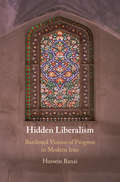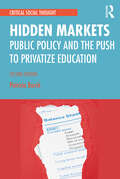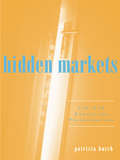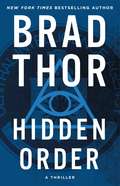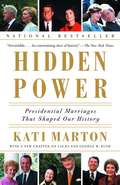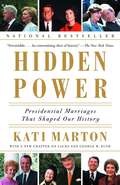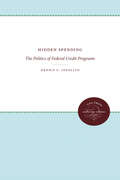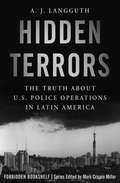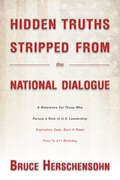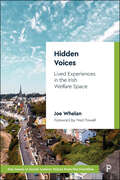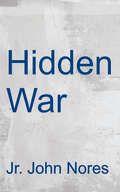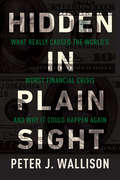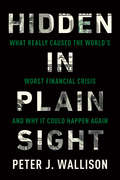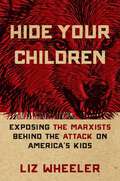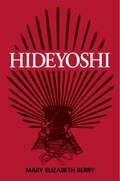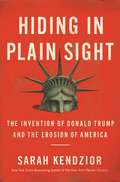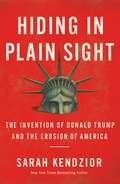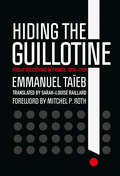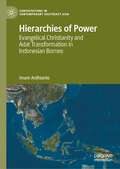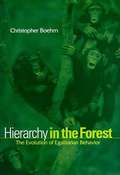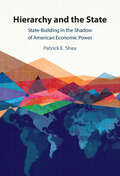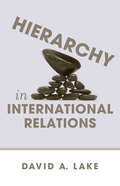- Table View
- List View
Hidden Liberalism: Burdened Visions of Progress in Modern Iran
by Hussein BanaiCompared to rival ideologies, liberalism has fared rather poorly in modern Iran. This is all the more remarkable given the essentially liberal substance of various social and political struggles – for liberal legality, individual rights and freedoms, and pluralism – in the century-long period since the demise of the Qajar dynasty and the subsequent transformation of the country into a modern nation-state. The deeply felt but largely invisible purchase of liberal political ideas in Iran challenges us to think more expansively about the trajectory of various intellectual developments since the emergence of a movement for reform and constitutionalism in the late nineteenth century. It complicates parsimonious accounts of Shi'ism, secularism, socialism, nationalism, and royalism as defining or representative ideologies of particular eras. Hidden Liberalism offers a critical examination of the reasons behind liberalism's invisible yet influential status, and its attendant ethical quandaries, in Iranian political and intellectual discourses.
Hidden Markets: Public Policy and the Push to Privatize Education (Critical Social Thought)
by Patricia BurchAcross the United States, test publishers, software companies, and research firms continue to take advantage of the revenues made available by federal policies like the No Child Left Behind Act, Race to the Top, and the Elementary and Secondary Education Act. In effect, the education industry has assumed a central place in the day-to-day governance and administration of public schools—a previously hidden trend that has begun to be a ubiquitous component of public education. Drawing on analytic tools, Hidden Markets examines specific domains that the education industry has had particular influence on—home schooling, remedial instruction, management consulting, test development, data management, and staff development. With updated and new material added, this second edition also highlights how technology and technology policy shape the conditions for teachers’ work, the role of natural disasters as education market opportunities, and the connection between racism and educational privatization. Burch's analysis demonstrates that only when we subject the education industry to systematic and in-depth critical analysis can we begin to demand more corporate accountability and organize to halt the slide of education funds into the market. Additional updates include: Discussion of the role that policy elites play in allowing CEOS to regulate the student identity market Examination of the rise of online tutoring engineered in part by the No Child Left Behind Act New chapter that offers an updated road map for policymakers and activists concerned about the issues raised within the book
Hidden Markets: The New Education Privatization (Critical Social Thought)
by Patricia BurchAcross the U.S., test publishers, software companies, and research firms are swarming to take advantage of the revenues made available by the No Child Left Behind Act. In effect, the education industry has assumed a central place in the day-to-day governance and administration of public schools—a trend that has gone largely unnoticed by policymakers or the press until now. Drawing on analytic tools, Hidden Markets examines specific domains that the education industry has had particular influence on—home schooling, remedial instruction, management consulting, test development, data management, and staff development. Burch's analysis demonstrates that only when we subject the education industry to systematic and in-depth critical analysis can we begin to demand more corporate accountability and organize to halt the slide of education funds into the market.
Hidden Order: A Thriller (The Scot Harvath Series #12)
by Brad Thor#1 New York Times and #1 Wall Street Journal bestselling author Brad Thor returns with his hottest and most action-packed thriller yet!The most secretive organization in America operates without accountability to the American people. Hiding in the shadows, pretending to be part of the United States Government, its power is beyond measure. Control of this organization has just been lost and the future of the nation has been thrust into peril. When the five candidates being considered to head this mysterious agency suddenly go missing, covert counter-terrorism operative, Scot Harvath is summoned to Washington and set loose on the most dangerous chase ever to play out on American soil. But as the candidates begin turning up murdered, the chase becomes an all-too-public spectacle with every indicator suggesting that the plot has its roots in a shadowy American cabal founded in the 1700s. With the United States on the verge of collapse, Harvath must untangle a web of conspiracy centuries in the making and head off the greatest threat America has ever seen. This is thriller writing at its absolute best where the stakes have never been higher, nor the line between good and evil so hard to discern.
Hidden Power: Presidential Marriages That Shaped Our History
by Kati Marton<p>Kati Marton’s bestselling Hidden Power is an engrossing look at twelve presidential marriages–from Edith and Woodrow Wilson to Laura and George W. Bush–that have profoundly affected America’s history. Marton uncovers the behind-the-scenes dynamics of the ultimate power couples, showing how first ladies have used their privileged access to the president to influence staffing, promote causes, and engage directly in policy-making. Edith Wilson secretly ran the country after Woodrow’s debilitating stroke. <p>Eleanor Roosevelt was FDR’s moral compass. And Laura Bush, initially shy of any public role, has proven to be the emotional ballast for her husband. Through extensive research and interviews, Marton reveals the substantial–yet often overlooked–legacy of presidential wives, providing insight into the evolution of women’s roles in the twentieth century and vividly depicting the synergy of these unique political partnerships.</p>
Hidden Power: Presidential Marriages That Shaped Our History
by Kati MartonKati Marton’s bestselling Hidden Power is an engrossing look at twelve presidential marriages–from Edith and Woodrow Wilson to Laura and George W. Bush–that have profoundly affected America’s history. Marton uncovers the behind-the-scenes dynamics of the ultimate power couples, showing how first ladies have used their privileged access to the president to influence staffing, promote causes, and engage directly in policy-making. Edith Wilson secretly ran the country after Woodrow’s debilitating stroke. Eleanor Roosevelt was FDR’s moral compass. And Laura Bush, initially shy of any public role, has proven to be the emotional ballast for her husband. Through extensive research and interviews, Marton reveals the substantial–yet often overlooked–legacy of presidential wives, providing insight into the evolution of women’s roles in the twentieth century and vividly depicting the synergy of these unique political partnerships.
Hidden Sorrow, Lasting Joy: The Forgotten Women of the Persecuted Church
by Anneke CompanjenStories of women persecuted for their faith around the world. Includes resources for helping.
Hidden Spending: The Politics of Federal Credit Programs
by Dennis S. IppolitoIppolito examines the least publicized source of our current fiscal troubles--federal credit programs. Since the 1970s these programs (primary components of the federal policy in such areas as housing, agriculture, education, and international affairs) have grown dramatically, but neither the growth nor their costs have been reflected in the budget. The true costs are not tangible and direct, but these programs can affect investment, economic growth, and productivity.Originally published 1984.A UNC Press Enduring Edition -- UNC Press Enduring Editions use the latest in digital technology to make available again books from our distinguished backlist that were previously out of print. These editions are published unaltered from the original, and are presented in affordable paperback formats, bringing readers both historical and cultural value.
Hidden Terrors: The Truth About U.S. Police Operations in Latin America (Forbidden Bookshelf #27)
by A. J. LangguthA &“devastating&” exposé of the United States&’ Latin American policy and the infamous career and assassination of agent Dan Mitrione (Kirkus Reviews). In 1960, former Richmond, Indiana, police chief Dan Mitrione moved to Brazil to begin a new career with the United States Agency for International Development. During his ten years with the USAID, Mitrione trained and oversaw foreign police forces in extreme counterinsurgency tactics—including torture—aimed at stomping out communism across South America. Though he was only a foot soldier in a larger secret campaign, he became a symbol of America&’s brutal interventionism when he was kidnapped and executed by Tupamaro rebels in Montevideo, Uruguay. In Hidden Terrors, former New York Times Saigon bureau chief A. J. Langguth chronicles with chilling detail Mitrione&’s work for the USAID on the ground in South America and Washington, DC, where he shared his expertise. Along the way, Langguth provides an authoritative overview of America&’s efforts to destabilize communist movements and prop up military dictators in South America, presenting a &“powerful indictment of what the United States helped to bring about in this hemisphere&” (The New York Times). Even today, the tactics Mitrione helped develop continue to influence operations in Guantanamo Bay, Cuba, and black sites around the globe.
Hidden Truths Stripped From the National Dialogue: A Reference For Those Who Pursue a Role In U.S. Leadership
by Bruce HerschensohnBruce Herschensohn challenges the same old beliefs most often heard in the media and read in the textbooks. Is Afghanistan really the longest war in the history of the United States? Was Hong Kong given back to the People’s Republic of China in 1997 because of the lease signed by Great Britain in 1898? Herschensohn convinces us with evidence that the answer to both questions is no.The book covers a wide range of controversial issues in domestic as well as international politics from US president’s constitutional rights to the Israeli-Palestinian Authority peace process. As you read on, you will realize sooner or later that you have been put into a “coma” by the media. This book is a call to start, reconsidering, questioning, and digging deeper into what the media feeds the public.Lucid, succinct, abundant in historical evidence, and easy to read, this book will draw general readers interested in contemporary politics as well as scholars and students of history and politics. But perhaps most important, it will win the applause of the people who like to engage in true critical thinking.
Hidden Voices: Lived Experiences in the Irish Welfare Space (Key Issues in Social Justice)
by Joe WhelanUnderpinned by the idea of the right to a ‘basic minimum’, welfare states are a major feature of many societies. However, the lived experiences of persons seeking and receiving welfare payments can often be overlooked. This book seeks to remedy this omission by honouring lived experience as valuable, insightful and necessary. It draws on qualitative interviews with 19 people receiving various working age welfare payments in Ireland to explore stigma, social reciprocity and the notions of the deserving and undeserving poor, and to analyse welfare conditionality in the Irish context. Breaking new ground, this book offers original research findings which contest and inform policy both within Ireland and beyond.
Hidden War: How Special Operations Game Wardens are Reclaiming America's Wildlands from the Drug Cartels
by Jr. John NoresDANGER On Your Public Lands! Death stalks America's wildlands. Indiscriminate destroyers of people, wildlife, and the environment, cartel marijuana growers will do anything to supply the black-market demand for weed. HIDDEN WAR, 2nd Edition, exposes this threat, give you a rare, inside glimpse into the operations of specially trained tactical teams with the California Department of Fish & Wildlife to infiltrate and take down these groups. In this updated and revised second edition of his popular 2019 book, Lt. John Nores, Jr., provides a sobering look at crimes against people and the environment on public lands as clandestine crime organizations and special forces game wardens go to war in a struggle that cuts across political ideologies about marijuana legalization.
Hidden in Plain Sight
by Peter J. WallisonThe 2008 financial crisis-like the Great Depression-was a world-historical event. What caused it will be debated for years, if not generations. The conventional narrative is that the financial crisis was caused by Wall Street greed and insufficient regulation of the financial system. That narrative produced the Dodd-Frank Act, the most comprehensive financial-system regulation since the New Deal. There is evidence, however, that the Dodd-Frank Act has slowed the recovery from the recession. If insufficient regulation caused the financial crisis, then the Dodd-Frank Act will never be modified or repealed; proponents will argue that doing so will cause another crisis.A competing narrative about what caused the financial crisis has received little attention. This view, which is accepted by almost all Republicans in Congress and most conservatives, contends that the crisis was caused by government housing policies. This book extensively documents this view. For example, it shows that in June 2008, before the crisis, 56 percent of all US mortgages were subprime or otherwise low-quality. Of these, 76 percent were on the books of government agencies such as Fannie Mae and Freddie Mac. When these mortgages defaulted in 2007 and 2008, they drove down housing prices and weakened banks and other mortgage holders, causing the crisis.After this book is published, no one will be able to claim that the financial crisis was caused by insufficient regulation, or defend Dodd-Frank, without coming to terms with the data this book contains.
Hidden in Plain Sight: What Really Caused the World's Worst Financial Crisisand Why It Could Happen Again
by Peter J. WallisonThe 2008 financial crisis-like the Great Depression-was a world-historical event. What caused it will be debated for years, if not generations. The conventional narrative is that the financial crisis was caused by Wall Street greed and insufficient regulation of the financial system. That narrative produced the Dodd-Frank Act, the mostcomprehensive financial-system regulation since the New Deal. There is evidence, however, that the Dodd-Frank Act has slowed the recovery from the recession. If insufficient regulation caused the financial crisis, then the Dodd-Frank Act will never be modified or repealed; proponents will argue that doing so will cause another crisis.A competing narrative about what caused the financial crisis has received little attention. This view, which is accepted by almost all Republicans in Congress and most conservatives, contends that the crisis was caused by government housing policies. This book extensively documents this view. For example, it shows that in June 2008, before the crisis, 58 percent of all US mortgages were subprime or other low-quality mortgages. Of these, 76 percent were on the books of government agencies such as Fannie Mae and Freddie Mac. When these mortgages defaulted in 2007 and 2008, they drove down housing prices and weakened banks and other mortgage holders, causing the crisis.After this book is published, no one will be able to claim that the financial crisis was caused by insufficient regulation, or defend Dodd-Frank, without coming to terms with the data this book contains.
Hide Your Children: Exposing the Marxists Behind the Attack on America's Kids
by Liz WheelerHaving conquered all the major institutions of our culture, the left is closing in on its final frontier—your children. In this new book, Liz Wheeler exposes where the forces of wokeness are at work and explains how parents can fight back for a change. Everything is on the line.Despite the occasional victory, conservatives are on the defensive on every front of the culture wars, especially America&’s schools. Planned Parenthood is funding gender theory indoctrination, groomer teachers are introducing youngsters to pornography, Disney executives are bragging about their &“queerness agenda,&” and teacher&’s unions are poisoning young minds with racism. If someone doesn&’t stand up and fight, these ideas will be the norm for a new generation. A distressing number of parents refuse to see how depraved our schools have become. The next generation will determine the fate of the American experiment in ordered liberty. Will they pass it on to their children, or will we lose our nation forever? Parents and their allies must go on the offensive in this existential fight. Fortunately, they have the truth on their side. It is not too late.
Hideyoshi (Harvard East Asian Monographs)
by Mary Elizabeth BerryHere is the first full-length biography in English of the most important political figure in premodern Japan.Hideyoshi—peasant turned general, military genius, and imperial regent of Japan—is the subject of an immense legendary literature. He is best known for the conquest of Japan’s sixteenth-century warlords and the invasion of Korea. He is known, too, as an extravagant showman who rebuilt cities, erected a colossal statue of the Buddha, and entertained thousands of guests at tea parties. But his lasting contribution is as governor whose policies shaped the course of Japanese politics for almost three hundred years.In Japan’s first experiment with federal rule, Hideyoshi successfully unified two hundred local domains under a central authority. Mary Elizabeth Berry explores the motives and forms of this new federalism which would survive in Japan until the mid-nineteenth century, as well as the philosophical question it raised: What is the proper role of government? This book reflects upon both the shifting political consciousness of the late sixteenth century and the legitimation rituals that were invoked to place change in a traditional context. It also reflects upon the architect of that change—a troubled parvenu who acted often with moderation and sometimes with explosive brutality.
Hiding In Plain Sight: The Invention Of Donald Trump And The Erosion Of America
by Sarah KendziorThe story of Donald Trump’s rise to power is the story of a buried American history – buried because people in power liked it that way. It was visible without being seen, influential without being named, ubiquitous without being overt. <p><p> Sarah Kendzior’s Hiding in Plain Sight pulls back the veil on a history spanning decades, a history of an American autocrat in the making. In doing so, she reveals the inherent fragility of American democracy – how our continual loss of freedom, the rise of consolidated corruption, and the secrets behind a burgeoning autocratic United States have been hiding in plain sight for decades. <p> In Kendzior’s signature and celebrated style, she expertly outlines Trump’s meteoric rise from the 1980s until today, interlinking key moments of his life with the degradation of the American political system and the continual erosion of our civil liberties by foreign powers. Kendzior also offers a never-before-seen look at her lifelong tendency to be in the wrong place at the wrong time – living in New York through 9/11 and in St. Louis during the Ferguson uprising, and researching media and authoritarianism when Trump emerged using the same tactics as the post-Soviet dictatorships she had long studied. <p> It is a terrible feeling to sense a threat coming, but it is worse when we let apathy, doubt, and fear prevent us from preparing ourselves. Hiding in Plain Sight confronts the injustice we have too long ignored because the truth is the only way forward.
Hiding in Plain Sight: The Invention of Donald Trump and the Erosion of America
by Sarah KendziorInstant New York Times BestsellerWashington Post BestsellerUSA Today BestsellerIndie Bound BestsellerAuthors Round the South BestsellerMidwest Indie BestsellerNew York Times bestselling author Sarah Kendzior documents the truth about the calculated rise to power of Donald Trump since the 1980s and how the erosion of our liberties made an American demagogue possible.The story of Donald Trump’s rise to power is the story of a buried American history – buried because people in power liked it that way. It was visible without being seen, influential without being named, ubiquitous without being overt. Sarah Kendzior’s Hiding in Plain Sight pulls back the veil on a history spanning decades, a history of an American autocrat in the making. In doing so, she reveals the inherent fragility of American democracy – how our continual loss of freedom, the rise of consolidated corruption, and the secrets behind a burgeoning autocratic United States have been hiding in plain sight for decades.In Kendzior’s signature and celebrated style, she expertly outlines Trump’s meteoric rise from the 1980s until today, interlinking key moments of his life with the degradation of the American political system and the continual erosion of our civil liberties by foreign powers. Kendzior also offers a never-before-seen look at her lifelong tendency to be in the wrong place at the wrong time – living in New York through 9/11 and in St. Louis during the Ferguson uprising, and researching media and authoritarianism when Trump emerged using the same tactics as the post-Soviet dictatorships she had long studied.It is a terrible feeling to sense a threat coming, but it is worse when we let apathy, doubt, and fear prevent us from preparing ourselves. Hiding in Plain Sight confronts the injustice we have too long ignored because the truth is the only way forward.
Hiding the Guillotine: Public Executions in France, 1870–1939
by Emmanuel TaïebHiding the Guillotine examines the question of state involvement in violence by tracing the evolution of public executions in France. Why did the state move executions from the bloody and public stage of the guillotine to behind prison doors? In a fascinating exploration of a grim subject, Emmanuel Taïeb exposes the rituals and theatrical form of the death penalty and tells us who watched, who participated in, and who criticized (and ultimately brought an end to) a spectacle that the state called "punishment." France's abolition of the death penalty in 1981 has long overshadowed its suppression of public executions over forty years earlier. Since the Revolution, executions attracted tens of thousands of curious onlookers. But, gradually, there was a shift in attitude and the public no longer saw this as a civilized pastime. Why? Combining material from legal archives, police files, an executioner's notebooks, newspaper clippings, and documents relating to 566 executions, Hiding the Guillotine answers this question.Taïeb demonstrates the ways in which the media was at the vanguard of putting an end to the publicity surrounding the death penalty. The press had ample reason to be critical: cities were increasingly being used for leisure activity and prisons for those accused of criminal activity. The agitation surrounding each execution, coupled with a growing identification with the condemned, would blur these boundaries. Ranked among the top hundred history books by the website, Café du Web Historizo, Hiding the Guillotine has much to impart to students of legal history, human rights, and criminology, as well as to American historians.
Hierarchical Capitalism in Latin America
by Ben Ross SchneiderThis book argues that Latin America has a distinctive, enduring form of hierarchical capitalism characterized by multinational corporations, diversified business groups, low skills and segmented labor markets. Over time, institutional complementarities knit features of corporate governance and labor markets together and thus contribute to institutional resiliency. Political systems generally favored elites and insiders who further reinforced existing institutions and complementarities. Hierarchical capitalism has not promoted rising productivity, good jobs or equitable development, and the efficacy of development strategies to promote these outcomes depends on tackling negative institutional complementarities. This book is intended to open a new debate on the nature of capitalism in Latin America and link that discussion to related research on comparative capitalism in other parts of the world.
Hierarchies of Power: Evangelical Christianity and Adat Transformation in Indonesian Borneo (Contestations in Contemporary Southeast Asia)
by Imam ArdhiantoThis book focuses on a Pentecostal-Evangelical Kenyah community in central Borneo, a region that crosses the border between Malaysia and Indonesia. The book argues that the Pentecostal-Evangelical (P/e) mode of religious authority and organization has the capacity to adapt to both the pre-existing hierarchical traditional institution such as Adat and modern egalitarian social forms. It has been necessary within the context of Kenyah’s experience of religious change as it enabled many actors from various social classes to obtain and perceive religious authority in a specific local and regional political-religious situation while promoting their identity as egalitarian and autonomous modern subjects. In contrast with other studies on the P/e church that emphasize its egalitarian spirit as a factor that supports its impressive growth, the book contends that its adaptive structural characteristics have enabled the development of this specific Christian denomination to expand rapidly and play a dominant position in contemporary social life in various parts of the world. The book thus provides novel findings in the study of religious change in Southeast Asia by enriching the discussion of historical transformation in the region, and analyzing the articulation of global and regional Christian movements, with the socio-political characteristics of Bornean society.
Hierarchy In The Forest: The Evolution Of Egalitarian Behavior
by Christopher BoehmAre humans by nature hierarchical or egalitarian? Hierarchy in the Forest addresses this question by examining the evolutionary origins of social and political behavior. Christopher Boehm, an anthropologist whose fieldwork has focused on the political arrangements of human and nonhuman primate groups, postulates that egalitarianism is in effect a hierarchy in which the weak combine forces to dominate the strong. The political flexibility of our species is formidable: we can be quite egalitarian, we can be quite despotic. Hierarchy in the Forest traces the roots of these contradictory traits in chimpanzee, bonobo, gorilla, and early human societies. Boehm looks at the loose group structures of hunter-gatherers, then at tribal segmentation, and finally at present-day governments to see how these conflicting tendencies are reflected. Hierarchy in the Forest claims new territory for biological anthropology and evolutionary biology by extending the domain of these sciences into a crucial aspect of human political and social behavior. This book will be a key document in the study of the evolutionary basis of genuine altruism. Table of Contents: The Question of Egalitarian Society Hierarchy and Equality Putting Down Aggressors Equality and Its Causes A Wider View of Egalitarianism The Hominoid Political Spectrum Ancestral Politics The Evolution of Egalitarian Society Paleolithic Politics and Natural Selection Ambivalence and Compromise in Human Nature References Index Reviews of this book: This well-written book, geared toward an audience with background in the behavioral and evolutionary sciences but accessible to a broad readership, raises two general questions: 'What is an egalitarian society?' and 'How have these societies evolved?'. . . [Christopher Boehm] takes the reader on a journey from the Arctic to the Americas, from Australia to Africa, in search of hunter-gatherer and tribal societies that emanate the egalitarian ethos--one that promotes generosity, altruism and sharing but forbids upstartism, aggression and egoism.
Hierarchy and the State: State-Building in the Shadow of American Economic Power
by Patrick E. SheaDoes American influence help or hinder the capacity-building of partner states? In Hierarchy and the State, Patrick E. Shea challenges the conventional wisdom that US influence undermines state-building in developing countries, instead arguing that US support has actually enhanced state capacity over the past forty years. The book asserts that American economic power plays a pivotal role in enhancing a state's ability to build and sustain itself. Tracing the evolution of US property rights promotion from 1782 to the present, it reveals the complex interplay of economic and security interests that shape American foreign policy. Through cutting-edge quantitative techniques and original data on US hierarchy, Hierarchy and the State provides robust evidence for the mechanisms linking international influence, property rights, and state-building outcomes. Its novel framework will change the way scholars examine the international politics of state-building.
Hierarchy in International Relations (Cornell Studies in Political Economy)
by David A. LakeInternational relations are generally understood as a realm of anarchy in which countries lack any superior authority and interact within a Hobbesian state of nature. In Hierarchy in International Relations, David A. Lake challenges this traditional view, demonstrating that states exercise authority over one another in international hierarchies that vary historically but are still pervasive today. Revisiting the concepts of authority and sovereignty, Lake offers a novel view of international relations in which states form social contracts that bind both dominant and subordinate members. The resulting hierarchies have significant effects on the foreign policies of states as well as patterns of international conflict and cooperation. Focusing largely on U.S.-led hierarchies in the contemporary world, Lake provides a compelling account of the origins, functions, and limits of political order in the modern international system. The book is a model of clarity in theory, research design, and the use of evidence. Motivated by concerns about the declining international legitimacy of the United States following the Iraq War, Hierarchy in International Relations offers a powerful analytic perspective that has important implications for understanding America's position in the world in the years ahead.
